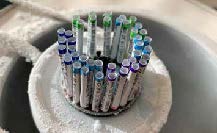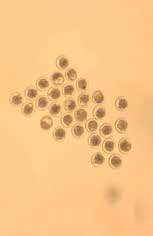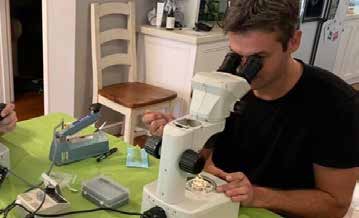
We asked renowned embryo transfer veterinarian, Dr Udo Mayne,
EmbryoLife, to provide some tips for transfer success with embryo transfer (ET) programs. Embryo flushing and transfer is carried out by a large proportion of Speckle Park stud breeders, growing herds in both quantity and quality.
Embryo transfer (ET) is widely used among
Speckle Park stud breeders as a means to grow their studs with both quantity and quality. Charlie Sutherland asked renowned embryo transfer veterinarian, Dr Udo Mahne, Embryo Life, to share his tips for success with ET.
How would an embryo transfer program benefit my stud program?
You can potentially increase the reproductive rate of a good cow by making more than one calf per year out of her. You could keep her embryos frozen as an insurance policy in case she dies or gets injured. Multiple embryo sibling calves make it possible to sell your best and capitalise on good heifers but still be able to keep some of them to grow your herd. You can potentially use an expensive bull semen straw to generate multiple calves.
How many semen straws do I need per donor cow?
Two Straws, 12 hours apart, are the standard number of straws used to cover a potential longer ovulation period when cows are super-ovulating multiple egg cells. If semen is of very good quality, a single straw, 12 hours after standing heat can be considered but this requires heat observation and a technician that is flexible and can come at that exact time.
Will the flush program impact the long-term fertility of my cow? How many times can I flush my donor cow?
No it will not impact her fertility nor will it influence her reproductive life span, as long as you use an experienced embryo technician and don’t flush the cow too many times before putting her to the bull to get back in calf. General rule of thumb is: flush twice only for minimum disturbance and inter-calving delay. A third flush could be considered if the technician is happy with the type of ovary and the condition of the cow. Fat cows struggle to fall pregnant.
How soon after calving can I flush my donor?
This depends on uterine health, size, parity, cow condition and nutrition. Donor cows must be at least 45 days past calving at the start of the program, which means they will be 65+ days post calving when flushed.
I’m unsure on what vitamin injections I should give my donor cow? Can you suggest any?
Minerals and vitamins are essential to generate healthy and strong egg cells. Selenium is a “must supplement” in almost all Australian cattle country where the rainfall is over 450mm per year. Vitamin A, D&E is another important supplement to give.
What is the average number of embryos a donor can produce?
The Speckle Park average is probably near 6-7 viable embryos per cow flushed. Speckle Park donors however vary tremendously on how many viable embryos they give. Some cows don’t give any embryos and other Speckle Park cows can give up to 42 usable embryos. Cows that give few embryos tend to continue with below average numbers and cows that flush well also continue that above average trend.
Is there much involved with preparing donor cows to flush?
There are a lot of times the cows have to come into the yards. Multiple injections (14) over a three-week period plus doing two Inseminations to fertilise the eggs.
Should I be supplement feeding my donor?
Yes. It is highly recommended to get the donor cows on a positive energy rising plane of nutrition.
Is pasture enough?
It could be if it contains multiple grass species and they have reached maturity. Lush green grass has inconsistencies and potential imbalances. It mostly isn’t a balanced healthy diet. Too much moisture, high protein and too little energy is a common problem with young and lush green pasture. Supplementing with good quality hay is always good for rumen health.
What difference does it make putting fresh embryos in versus frozen embryos?
There could be no difference. Statistically, there could be a 10-15% better conception rate with fresh embryos.
Success rate of ET?
Stock and pasture management has the biggest impact on conception rates. This includes vaccinations and disease control. Pestivirus, IBR virus and vibriosis infections after transfer can lead to complete failures or massive early pregnancy losses. While doing the exact same thing, I have seen differences from 30% up to 100% pregnancy rates. The average pregnancy rate on an uneventful program should be around 70% if the recipient nutrition was well managed.
Is there much difference between Grade 1 and 2 embryos?
10-15% is the general rule of thumb.
What advice would you give to someone who is undertaking their first ET program?
Do proper research, and talk to other farmers that are doing embryo programs. Find out what are the Do’s and Dont’s for transfer success. There are a lot of potential potholes that need filling or avoiding.

 We asked renowned embryo transfer veterinarian, Dr Udo Mayne, EmbryoLife, to provide some tips for transfer success with embryo transfer (ET) programs. Embryo flushing and transfer is carried out by a large proportion of Speckle Park stud breeders, growing herds in both quantity and quality.
Embryo transfer (ET) is widely used among Speckle Park stud breeders as a means to grow their studs with both quantity and quality. Charlie Sutherland asked renowned embryo transfer veterinarian, Dr Udo Mahne, Embryo Life, to share his tips for success with ET.
We asked renowned embryo transfer veterinarian, Dr Udo Mayne, EmbryoLife, to provide some tips for transfer success with embryo transfer (ET) programs. Embryo flushing and transfer is carried out by a large proportion of Speckle Park stud breeders, growing herds in both quantity and quality.
Embryo transfer (ET) is widely used among Speckle Park stud breeders as a means to grow their studs with both quantity and quality. Charlie Sutherland asked renowned embryo transfer veterinarian, Dr Udo Mahne, Embryo Life, to share his tips for success with ET.


